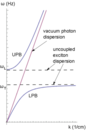Chapter 2: Dielectric Properties Flashcards
(90 cards)
Goal of Studying Dielectrics Properties
(3 points)
Determine relation between microscoptic and macroscopic descriptions of how solids as a whole respond to electric field
- Microscopic VIew: photon creates phonon and/or electron-hole
- Macroscopic View: absorption described by Maxwell’s Equations and optical absoroption coefficient
Macroscopic Electrodynamics
(Assumptions: 2 points)
- Linear response
- i.e. small fields, no saturation effects, etc
Response of solid to electric field
(3 points)
- Depends on charge mobility
- Metals: free charge carriers → screening of E at short distances
- Insulators: small electron motion (polarization) → screening of E at long distances
Insulator response to
E = E*exp[i(qr-ωt)]
Small displacement induces polarization

Dielectric Displacement Field
(2 points)
- Accounts for effects of free and bound charges in material (only free charges are source)

Dielectric Function
(Insulators: 3 points)
- Usually, wavelength of EM wave λ >> a lattice constant

Metal response to
E = E*exp[i(qr-ωt)]
Electric current forms
Maxwell’s Equations

Generalized conductivity
(5 points)
- Consider ∇ × H with J = σE and D(ω) = εoε(ω)E
- Real part: due to free charges; dominates in metals
- Imaginary part: due to polarized charges

Generalized dielectric constant
(3 points)
- Real part: due to polarization
- Imaginary part: due to free charges

Kramer-Kronig Relationship
(Assumptions: 2 parts)
- Linear response
- E(ω) ∝ P(ω) → χ(ω) and ε(ω) are linear functions
Kramer-Kronig Relationship
(Take-Away)
- Measuring either real or imaginary part over entire sepctrum allows recovering the other part

Absorption, Transmission, and Reflection of EM Radiation
(Overview)
There exists connection between dielectric properties and optical parameter of solid
Absorption, Transmission, and Reflection of EM Radiation
(Assumptions: 3 points)
- Uncharged solid ∇ · D = ρfree = 0
- Non-magnetic material µ = 0
- From MW-equations (see below)
- Should by vph2 in denominator

Absoroption, Transmission, and Reflection of EM Radiation
(Propagation (phase) Velocity)
Speed of EM wave in material

Absorption, Transmission, and Reflection of EM Radiation
(Complex Refractive Index: 2 points)
- n(ω): refractice index
- K(ω): absorption coefficient

Absorption, Transmission, and Reflection of EM Radiation
(Complex Wave Vector)
- Recall: Dispersion relation ω = ck/n

Absorption, Transmission, and Reflection of EM Radiation
(Complex refractive index: graph)

Absorption, Transmission, and Reflection of EM Radiation
(Take-Away)
- Solution with complex wave vector is damped wave (see below)

Absorption, Transmission, and Reflection of EM Radiation
(Take-Away: graph)

Absorption, Transmission, and Reflection of EM Radiation
(Take-Away: Absorption Coefficient)
Provides relationship between experimentall measureable quantity K and dielectric property of material ε

The Local Electric Field Eloc
Due to shielding, local electric field generally not identical to external field

The Local Electric Field
(The Dipole Electric Field Edip: 5 points)
- Lorentz field EL
- Depolarization field EN
- Depolarization factor N
- Macroscopic polarization P

The Local Electric Field
(Diagram)














- Leads to Curie Law of MAgnetic Susceptability




























